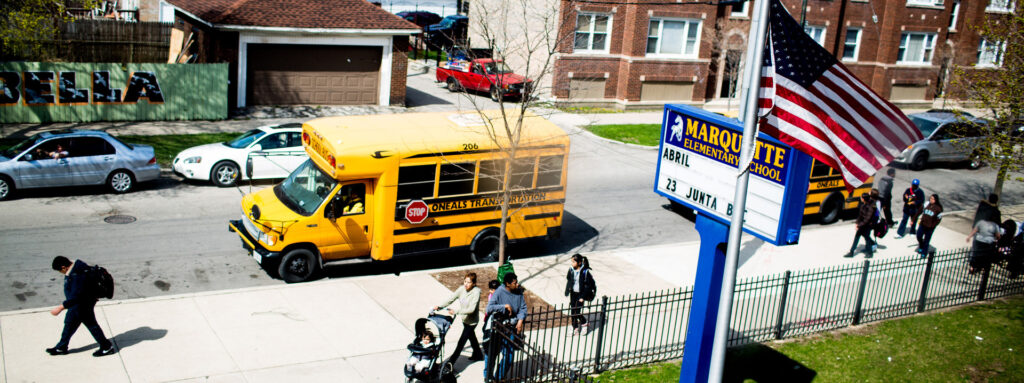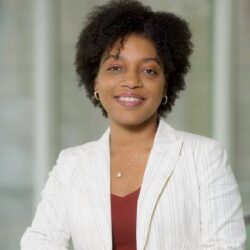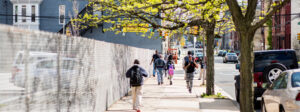As administrators, teachers, or any other sort of “expert” in education, we can often come into school communities thinking we know the answers, that we can “fix” things. When I started my career as a school leader, I knew I wanted to avoid that. I didn’t want to be some kind of savior. But I also wanted to get down to business—and that’s not always an easy balance.
In 2013, I took a position as Assistant Principal of Gary Comer College Prep because I’d fallen in love with the city of Chicago and was eager to be part of its education community. But as much as I loved the city, and though, as a black woman, I looked like many of the kids at the school, as a middle-class southerner from Georgia, I was an outsider in Comer’s Southside neighborhood. I knew almost nothing about the local community and didn’t want to come into Comer acting as though I knew what was right for its children more so than people who had known them for years.
So, when Sam Binion, the school’s security guard and a neighborhood icon, greeted me on my first day, I jumped at the chance to learn.
[subscribe]
Sam told me the school’s small triangular neighborhood, with a cemetery on one side and sets of train tracks on the other, was affectionately known as “Pocket Town.” We talked about his experience growing up in the community and becoming friends with the Comer family when they were building the school. He told me that most people in the neighborhood saw the school as this “big, beautiful building behind iron gates,” and that no one really went near the school unless they had had a kid there. That last part was hard for me to hear. I didn’t want the community to feel like our school was happening to them. Instead, I wanted them to feel like we’re partners, all working together to educate our kids. I set out to change this perception, and getting to know Sam—who I soon learned was known in the neighborhood as “The Mayor of Pocket Town”—was a crucial first step.
As Sam and I continued to chat regularly, I learned about local businesses, the neighboring Gary Comer Youth Center, and the many other things the people in the neighborhood love about where they live. I bombarded Sam with so many questions that he finally said, “Let’s just take a walk, Ms. Grier, and you can put some faces to the names.” And with that, we were off on the first of many community walks through Pocket Town.
Our first stop was the Youth Center, which at the time had about 25 percent of Comer’s students among its members. There I met Mr. Cardell King Sr., officially front desk security and unofficially the “Father of the Youth Center.” In his straight-forward fatherly way, he said to me, “It’s about time they got some of us over in that school. These kids need role models that look like them. You’re going to do a great job. We’re happy to have you.” Though Mr. King was speaking casually, I knew he was commenting on the school’s staff, which, at 87 percent White, didn’t much resemble the 99 percent Black student population.
Sam walked me up and down the streets of Pocket Town. I met his family, the owner of the area apartment complex, some young men who always hung out in front of the corner store, the gas station owner, the junkyard owner, local pastors, and the principal at the elementary school. At each of our stops, Sam introduced me as the new Assistant Principal and made an explicit bridge between the community member and me. He allowed me space to share my vision for our school, ask questions, and address any concerns. He also sternly told the young men in front of the corner store not to bother the Comer students or the school. “Ms. Grier is doing good work up there,” he said, “and we need to support her efforts.” The young men nodded in agreement, and stayed true to their word; in my three years at Comer, we only had a few challenges with them, and those challenges were easily resolved.
On that first walk, I promised the community that I would be accessible. I encouraged them to inform me if students were doing great things in the community, and also to let me know when their behavior didn’t represent the school well or disturbed the businesses. I also challenged the people I met to get involved and hold me accountable for the things I’d promised. This piece was especially important to me because community engagement is not just about taking walks; it’s about building sustained relationships and working together to amplify the great things that are happening in the neighborhood and the school.
[related]
As the year progressed, I maintained these connections and developed relationships with other people in the area, like the district police commander and the neighborhood Alderman. By the following year, when I was named Principal of Comer, I was in a great position to share these connections with my teaching staff.
The first thing I did was address Mr. Cardell King Sr.’s concerns about our staff’s diversity. I made an effort to recruit and retain more teachers of color, and within three years, the school staff grew from less than 10 percent staff of color to over 40 percent staff of color. Though our demographics still didn’t fully reflect the neighborhood, we were making progress.
I also made community engagement a non-negotiable. Since my first walk with Sam was so helpful, I required every teacher to attend a community walk like mine. Teachers’ responses to this new community engagement strategy were overwhelmingly positive. Several told me that the walks allowed them to relate to their students on a whole different level and better understand how to teach them.
But it’s not just about sending teachers out into the community; it’s also important to bring the community into the school. Working alongside our neighborhood partners, we opened the school’s “big iron gates”; the Alderman held meetings in the school auditorium, and a local church had service there on the weekends.
That same school year, partnerships between Comer the school and Comer the youth center—which previously were minimal—allowed for shared ideas and opportunities to flourish. We shared programming, spaces, and even staff members. As a result, Youth Center membership increased by 50 percent, meaning 50 percent more students had access to a safe place to study, eat dinner, and participate in after-school enrichment programs.
Without community, there is no real success for our schools. After all, much of what students learn they learn outside the classroom. As far as I’m concerned, it’s every educator’s responsibility to know where their students come from and be interested in the vibrant stories they bring to school. But we can’t do this without the community that made these kids, and so graciously trusted us to educate them. Because, as I saw at Comer, the community and school that partner together stay together.





